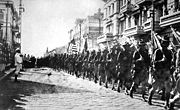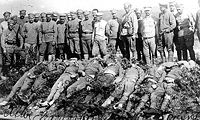
American Expeditionary Force Siberia
Encyclopedia

Expeditionary warfare
Expeditionary warfare is used to describe the organization of a state's military to fight abroad, especially when deployed to fight away from its established bases at home or abroad. Expeditionary forces were in part the antecedent of the modern concept of Rapid Deployment Forces...
Siberia (AEF Siberia) was a United States Army
United States Army
The United States Army is the main branch of the United States Armed Forces responsible for land-based military operations. It is the largest and oldest established branch of the U.S. military, and is one of seven U.S. uniformed services...
force that was involved in the Russian Civil War
Russian Civil War
The Russian Civil War was a multi-party war that occurred within the former Russian Empire after the Russian provisional government collapsed to the Soviets, under the domination of the Bolshevik party. Soviet forces first assumed power in Petrograd The Russian Civil War (1917–1923) was a...
in Vladivostok
Vladivostok
The city is located in the southern extremity of Muravyov-Amursky Peninsula, which is about 30 km long and approximately 12 km wide.The highest point is Mount Kholodilnik, the height of which is 257 m...
, Russian Empire
Russian Empire
The Russian Empire was a state that existed from 1721 until the Russian Revolution of 1917. It was the successor to the Tsardom of Russia and the predecessor of the Soviet Union...
, during the tail end of World War I
World War I
World War I , which was predominantly called the World War or the Great War from its occurrence until 1939, and the First World War or World War I thereafter, was a major war centred in Europe that began on 28 July 1914 and lasted until 11 November 1918...
after the October Revolution
October Revolution
The October Revolution , also known as the Great October Socialist Revolution , Red October, the October Uprising or the Bolshevik Revolution, was a political revolution and a part of the Russian Revolution of 1917...
, from 1918 to 1920.
President Woodrow Wilson
Woodrow Wilson
Thomas Woodrow Wilson was the 28th President of the United States, from 1913 to 1921. A leader of the Progressive Movement, he served as President of Princeton University from 1902 to 1910, and then as the Governor of New Jersey from 1911 to 1913...
's objectives for sending troops to Siberia
Siberia
Siberia is an extensive region constituting almost all of Northern Asia. Comprising the central and eastern portion of the Russian Federation, it was part of the Soviet Union from its beginning, as its predecessor states, the Tsardom of Russia and the Russian Empire, conquered it during the 16th...
were as much diplomatic as they were military. One major reason was to rescue the 40,000 men of the Czechoslovak Legions
Czechoslovak Legions
The Czechoslovak Legions were volunteer armed forces composed predominantly of Czechs and Slovaks fighting together with the Entente powers during World War I...
, who were being held up by Bolshevik forces as they attempted to make their way along the Trans-Siberian Railroad to Vladivostok
Vladivostok
The city is located in the southern extremity of Muravyov-Amursky Peninsula, which is about 30 km long and approximately 12 km wide.The highest point is Mount Kholodilnik, the height of which is 257 m...
, and it was hoped, eventually to the Western Front. Another major reason was to protect the large quantities of military supplies and railroad rolling stock that the United States had sent to the Russian Far East in support of the prior Russian government's war efforts on the Eastern Front. Equally stressed by President Wilson was the need to "steady any efforts at self-government or self defense in which the Russians themselves may be willing to accept assistance." At the time, Bolshevik forces controlled only small pockets in Siberia and Wilson wanted to make sure that neither Cossack
Cossack
Cossacks are a group of predominantly East Slavic people who originally were members of democratic, semi-military communities in what is today Ukraine and Southern Russia inhabiting sparsely populated areas and islands in the lower Dnieper and Don basins and who played an important role in the...
marauders nor the Japanese military would take advantage of the unstable political environment along the strategic railroad line and in the resource-rich Siberian regions that straddled it.
Concurrently and for similar reasons, about 5,000 American soldiers were sent to Arkhangelsk (Archangel)
Arkhangelsk
Arkhangelsk , formerly known as Archangel in English, is a city and the administrative center of Arkhangelsk Oblast, Russia. It lies on both banks of the Northern Dvina River near its exit into the White Sea in the north of European Russia. The city spreads for over along the banks of the river...
, Russia by President Wilson as part of the separate Polar Bear Expedition
Polar Bear Expedition
The Polar Bear Expedition was a contingent of about 5,000 U.S...
.
American Expeditionary Force Siberia

William S. Graves
Major General William Sidney Graves . The commander of American forces in Siberia during the Allied Intervention in Russia.-Biography:...
and eventually totaled 7,950 officers and enlisted men. The AEF Siberia included the U.S. Army's 27th
27th Infantry Regiment (United States)
The 27th Infantry Regiment, nicknamed the Wolfhounds, is a unit of the United States Army established in 1901, that served in the Philippine-American War, in the Siberian Intervention after World War I, and as part of the 25th Infantry Division during World War II, the Korean War, and later the...
and 31st Infantry Regiments, plus large numbers of volunteers from the 13th
13th Infantry Regiment (United States)
The 13th Infantry Regiment is a United States Army infantry regiment whose battalions are currently tasked as basic training battalions.- History :...
and 62nd Infantry Regiments
62nd Infantry Regiment (United States)
The 62nd Infantry Regiment was an Regular infantry regiment in the United States Army.-Lineage:Constituted 15 May 1917 in the Regular Army as the 62nd Infantry. Organized 1 June 1917 at the Presidio of San Francisco, Calafornia, from personnel of the 12th infantry. Assigned to the 8th Infantry...
along with a few from the 12th Infantry Regiment.
The U.S. troops were equipped with the M1903 Springfield rifle, M1918 Browning Automatic Rifles (BAR), and M1911 .45 caliber pistols, depending on their duties.
Although General Graves did not arrive in Siberia until September 4, 1918, the first 3,000 American troops disembarked in Vladivostok between August 15 and August 21, 1918. They were quickly assigned guard duty along segments of the railway between Vladivostok and Nikolsk-Ussuriski in the north.
Unlike his Allied counterparts, General Graves believed their mission in Siberia was to provide protection for American-supplied property and to help the Czechoslovak Legions
Czechoslovak Legions
The Czechoslovak Legions were volunteer armed forces composed predominantly of Czechs and Slovaks fighting together with the Entente powers during World War I...
evacuate Russia, and that it did not include fighting against the Bolsheviks. Repeatedly calling for restraint, Graves often clashed with commanders of British
Great Britain
Great Britain or Britain is an island situated to the northwest of Continental Europe. It is the ninth largest island in the world, and the largest European island, as well as the largest of the British Isles...
, French
France
The French Republic , The French Republic , The French Republic , (commonly known as France , is a unitary semi-presidential republic in Western Europe with several overseas territories and islands located on other continents and in the Indian, Pacific, and Atlantic oceans. Metropolitan France...
and Japan
Japan
Japan is an island nation in East Asia. Located in the Pacific Ocean, it lies to the east of the Sea of Japan, China, North Korea, South Korea and Russia, stretching from the Sea of Okhotsk in the north to the East China Sea and Taiwan in the south...
ese forces, who also had troops in the region and who wanted him to take a more active part in the military intervention in Siberia.
Logistic problems and casualties
The experience in Siberia for the soldiers was miserable. Problems with fuel, ammunition, supplies and food were widespread. Horses accustomed to temperate climates were unable to function in sub-zero Russia. Water-cooled machine guns froze and became useless.The last American soldiers left Siberia on April 1, 1920. During their 19 months in Siberia, 189 soldiers of the American Expeditionary Force Siberia died from all causes. As a comparison, the smaller American North Russia Expeditionary Force
Polar Bear Expedition
The Polar Bear Expedition was a contingent of about 5,000 U.S...
experienced 235 deaths from all causes during their 9 months of fighting near Arkhangelsk
Arkhangelsk
Arkhangelsk , formerly known as Archangel in English, is a city and the administrative center of Arkhangelsk Oblast, Russia. It lies on both banks of the Northern Dvina River near its exit into the White Sea in the north of European Russia. The city spreads for over along the banks of the river...
.
External links
- The Russian Railway Service Corp in Japan and Siberia
- The Story of the American Expeditionary Forces
- Guarding the Railroad, Taming the Cossacks The U.S. Army in Russia, 1918–1920 at The National Archives
- America's Secret War Hundreds of photos.
- The Czech Legion Web site of the Czech Legion Project, contains historical information and many photos.
- Polar Bear Expedition Digital Collections An interactive site featuring the digitized Polar Bear collections of various soldiers and organizations housed at the Bentley Historical Library. The materials consist of more than 50 individual collections of primary source material, including diaries, maps, correspondence, photographs, ephemera, printed materials, and a motion picture.
- "Detroit's Own" Polar Bear Memorial Association
Further reading
- "On the invasion of Russia" (1920; Reprint 2004 Reprint ISBN 1-4191-9446-1) review on Humanties and Social Sciences Online. Article retrieved March 10, 2006.
- "On the AEF Siberia

